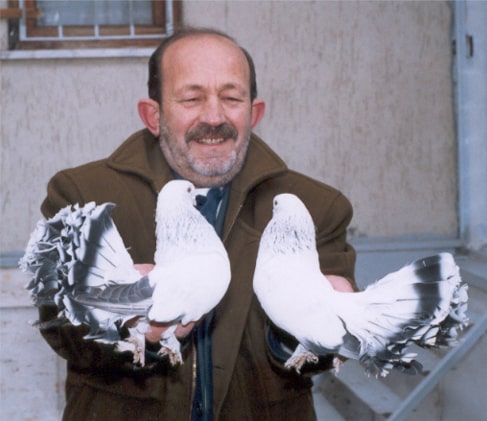
SELÇUKLU
"Selçuklu", "Selçuk or as its known by the people of Konya, "enseli" (necked), belongs to the city of Konya, one time capital of the Seljuk Dynasty. The word ense (neck), is used to describe the tail of the bird. This breed is known as "Seljuk Fantail", "Seldjucken" type of names around the world. It is a documented fact that the well-known leaders of the Sufisizm and the Whirling Dervishes, a great poet and philosopher "Mevlana Celalettin Rumi", who lived in early 1200s was also a fancier of this breed. After him the followers of his teachings the Sufi çelebi's (title of the leader of the Derviş order) continued to keep this breed and contributed greatly to its existence today.
It is known that this breed was kept and protected within the walls of Seljuk palaces during the Anatolian Seljuk Empire times. After the Seljuks, they were kept by a few wealthy families, who did not sell or gifted any to anyone else, hence it took a long time for their arrival to the Ottoman palaces. Evliya Çelebi did not mention this breed in 1635, when listing the pigeon breeds of İstanbul. We see their arrival in the palace in 1875 during the time of Sultan Abdülhamit II.
This breed's bare existence outside of Konya is explained by its entrance to Anatolia by the way of Seljuk Turks. Their frequent appearances in Seljuk miniatures also supports this theory. Besides, the old fanciers of Konya talking about the Ottoman times also verify this.
SELÇUKLU PIGEONS ARE DISAPPEARING RAPIDLY
Since Selçuks are not kept throughout the country, the breed and its characteristics are not well known. In fact, it makes you think and worry that the website prepared by the Konya municipality contains a large article on pigeon keeping tradition of the city but fails to mention this breed. Number of old breeders that keep Selçuks in Konya also has been declining and this makes it more alarming. Today the future of this breed is in real danger, and it needs to be put under protection.
Last few years some birds have been taken out of the country and bred abroad. However, it is also not a common breed outside the country and unfortunately these birds' characteristics have not been protected and degenerated. According to a German source a pair was in 1982 Nurnberg show and another in 1991 Stuttgart show.
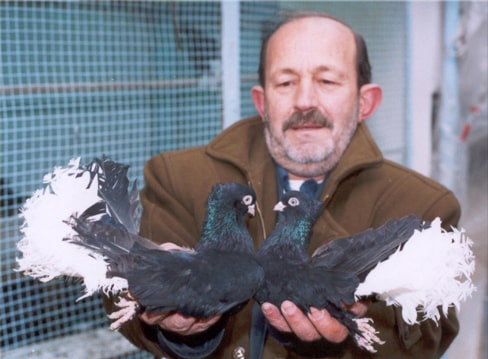
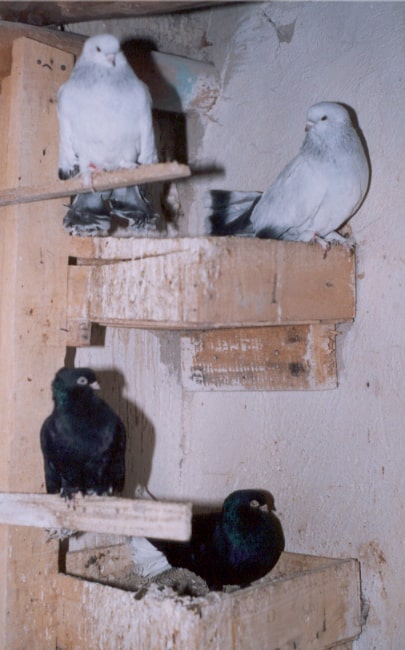
BODY STRUCTURE
Selçuk is a form (shape, structure) breed. Its looks and colors are always carrying the primary importance. Because of this they are not flown but kept in aviaries or gardens. When flown they don't go far and fly only a few rounds around the loft. During flight they will tumble straight, going forward, in single tumble format. Even though, the ones tumble are considered to be better of them the ones that do not tumble are not disqualified as decent birds. Birds of this breed has a unique body shape. Before anything, they are rather small birds. Fanciers also look for this quality in their birds. In pigeon terminology, "1 esnek" (one elastic), meaning the holding the thumb and the index finger of one's hand in U shape, about 8cm. (Approximately 3.14 inches) apart from each other, is the standard measurement between the starting point of the chest and the anus. In relation to this measurement the back of the birds must be shorter also.
Body shape must be round like a ball. Chest must be rather bulging and round. Head must be carried back. This style of head structure is called "Kısrak Kafa" (Mare Head), named after the Arabian horse. They have a medium size beak, length, and width. Shape of the beak is stretched (wide). Eyes are, in the "wide eye" style, large and round with a wide eye ring around. Eye rings are either white color or quince yellow color. Color of the eyes can be white, black, blue or light scarlet. Sometimes, there can be thin lines of red coloring called "nergiz" (narcissus) seen in the eyes, but this is not a desired quality in this breed. Legs are covered with short muffs. They are never clean legged. They can be plain headed or with a head crest. Ones with the head crest, the crest must extend from one ear to the other. Their most noticeable quality is the tail: Tail, called "ense" (neck), must be wide. All Selçuks come with ense. Tail is in the style called "deste" (bouquet) or "top" (ball) must be raised up and in a triangle shape. Sometimes it is possible to see some with what is called "köprülü ense" (bridged neck) tails, which the tail takes the shape of a half-moon. Shape of the tail is just like the fan tails, somewhat upwards and a fan like shape.
-moon. Shape of the tail is just like the fan tails, somewhat upwards and a fan like shape. Raised tail is the preference for the breed. Number of tail feathers are much more than an average pigeon breed. This number must be minimum 24-26 and maximum 36. Birds are named differently based on the tail shape. Tail can be, as far as the looks go, full in the inside or empty. Based on this quality Selçuks are divided into two groups. Ones with the full in the inside of the tail, have their feathers lined up one under the other. This is called "kılıncına dolma" (sword full) and it is a desired quality. If the section under the tail is not full, I mead the feathers are not lined up under each other but lined up in an angle next to each other, this is called "açık ense" (open neck). Open necks have an empty tail inside. Besides these there are also "sokma kuyruk" (stuck tail) and dalma (diving) as descriptions of tail shape.
PREFERRED QUALITIES
Single tumbles while flying. Head crests from one ear to the other. Large and round heads. Short, thick, and wide beaks. Ones with long necks that extend backwards. Stand called "kısrak kafa" where the head and the beak are curved towards the body. Ones with short backs. "1 esnek" length. Large eye rings. Ones with white of the that is very white and without hair-veins. Ones with the most tail feathers. Tail stand is almost touching the back of the head are all desired qualities for fanciers of this breed.
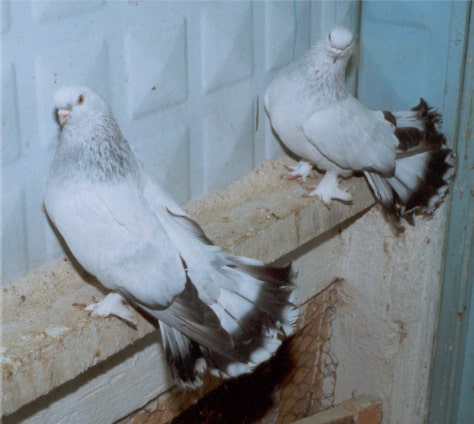
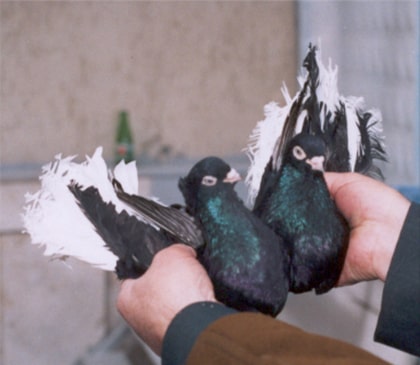
COLOR
Based on the general knowledge and understanding, we believe the Selçuk Turks only brought white-selfs, black-selfs and blues from Central Asia with them. It is a known fact that the colors that can be seen today are the breeding programs that took place in Anatolia. Common colors of today are Ak, Kara, Gök, Çopur, Akkuyrukkara, in addition to these, there are also Pal and Ala colors.
Ak:This is a color that was brought into Anatolia by Selçuks. Color of the birds are simply white-self and known as "enseli ak".
Kara:This is a color that was brought into Anatolia by Selçuks. Color of the birds are black-self and also known as "enseli kara" and "enseli zidgara". Large and white eyes are desired.
Gök: This is a color that was brought into Anatolia by Selçuks. In general, they are barless light bluebar color. Meaning the body having the mix of light blue and gray colors. They are also known as "enseli gök". Birds with the more of an ashy color (dark or dirty blue) or if there are any white coloring on them are not desired.
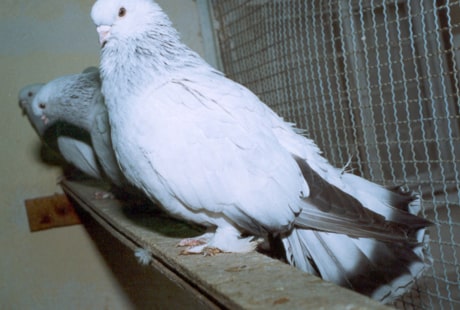
Pal:Also known as "enseli pal". This color can be obtained by pairing an ak and a gök or pairing a çopur with çopur, in this case 80% of the young birds. Color of the birds are mix of white and blue. Blue tends to be darker ashier. Tail is generally white. Mixing of white and blue can occur anywhere in the body in grizzle format. Since this is a form breed, this coloring is one of the least liked colors by fanciers. Most old fanciers do not even consider it to be color factor in this breed.
Ala: Also known as "enseli ala. It is a mix of ak and kara colors. Ala (pied) terminology is used in pigeons as mix of colors. Birds' head, body, wings, tail as main parts of the body being different colors and these colors evenly distributed into these parts can be seen as a separate color. For Selçuks, ala is where the head is completely black, body is only white or black and the tail is white. Alas in general come with "çakır" (gray with blue streaks) eyes. Their tails are always empty in the inside.
Çopur:This is a color that was created with genetic breeding during the Ottoman times. In these birds the head is silver-blue color. This color ends at the bottom of the neck in a clear and strait line. From this point the color of the body is white. Any running of the silver blue into white is not acceptable. There can be one exception and that is the pattern called "çakal" (jackal), which is a single white line starting from the top end of the beak and going up between the eyes into the middle of the head. This is a desired future for çopur color. Under no circumstances there can be any blue coloring on the body of the bird. Body must be completely white. Wings however are a different matter; They are a clear saddle marking in black or very dark gray color. There can be two bars on the wings. If the wing tips are dark dun or brown, these birds are considered to be very valuable.
At times, çopur color birds can have what we call "çallı" one or two white feathers. These birds are considered to have no value. Most çopurs have white tail. However, they can have a black tail. These birds are called "karakuyruk çopur" Tails can come in full in the inside or empty. Çopur color birds come with gray eyes that have tiny streaks of either blue or beige lines. The other eye color is one eye black the other is being half black half gray with blue or beige streaks. Black half can be at the bottom, top or one side of the eye.
Çopur was established with using genetic breeding techniques on ak and gök birds. When Ak and gök is paired, çopur, karakuyruk çopur and gök colors can be obtained. When çopur is paired with another çopur, 80% pal, 15% çopur and 5% ak can be obtained.The person credited for creation of çopur color and a person who was in love with this color is Elifin İbrahim Babadağ. We can easily say that we owe the continuation of this color to this gentleman who spent most of his life as the head bird keeper in the mansion of Hacı Nafiz family of Konya.
There is also a little anecdote about çopur; It is a known fact the Ottoman Sultan Abdülhamid II. was a pigeon lover since his prince years. After becoming a sultan, he ruled the empire for 33 years between 1876-1909. This sultan's head bird keeper Osman Efendi is the grandfather of our famous national team players (soccer) Şükrü bey and Rüştü bey. At this time in the palace there were 32 pigeon keepers that worked for Osman Efendi. One of these pigeon keepers was the Konya's very own Nakip Zade family's member Rıza Efendi. Hearing the fame of Selçuks Abdulhamid II. orders Rıza Efendi to go to Konya and bring all varieties of this breed to the palace in İstanbul. Responding to this, Rıza Efendi goes to Konya and gathers all varieties and brings them back to İstanbul. Out of all the birds that were brought over sultan likes the ones called "takkeli (crested) çopur" and orders Rıza Efendi to go back to Konya and get more birds in this color. However, Rıza Efendi could only get 3 other birds to bring back to his sultan form the fanciers of Konya.
Sultan seeing the beauty of the Selçuks decides to get rid of all the foreign breeds from his stock and send them to Konya as a gift to the fanciers who were wishing to keep them. The head police chief of Konya who was also a famous fancier of that time, was the person in charge of distribution of these birds.
There are supporting documents of these events in the Ottoman archives today. During my research of the Ottoman archives, I have ran into many document showing the heavy pigeon traffic between Konya and the palace in İstanbul. 1883 dated one document states the birds that are supposed to be sent to palace from Konya are being turned over to Captain İbrahim Ağa. 1893 dated another document is a request for pure birds from Konya. 1899 dated document states that there are 195 pairs of pigeons being sent to the fanciers of Konya from the palace in İstanbul.
Akkuyrukkara:This is a color that was created with genetic breeding during the Ottoman times. These birds come with a black body and white tail. They were created over many years with breeding of ak and kara colors. From these pairings’ ala, mavrullukara and akkuyrukkara types of colors can be obtained. Mavrullukara is a name given to akkuyrukkara birds that have black coloring on the white tail. Besides these, "yanı telli (side wired), böğrü telli (tummy wired) and üstü telli (top wired)" named feather and wing feather coloring can be seen (term wired being used for single white feathers). Person that worked on the creation of akkuyrukkara during the Ottoman times is the Rafet çelebi's son Hüseyin Çelebi. Therefore, we can say that we owe this color to him. These birds can be with or without head-crest. Ones with the crests that extend from one ear to the other are considered to be the most valuable. Tail shape can be open in the inside or "kılıncına dolma" (sword full). "Kılıncına dolma" is the preferred type of the two. Eyes must be large and framed (surrounded by a ring). Eye colors can be white, green, or scarlet. Birds with scarlet eyes are considered to be mixed and not valued.
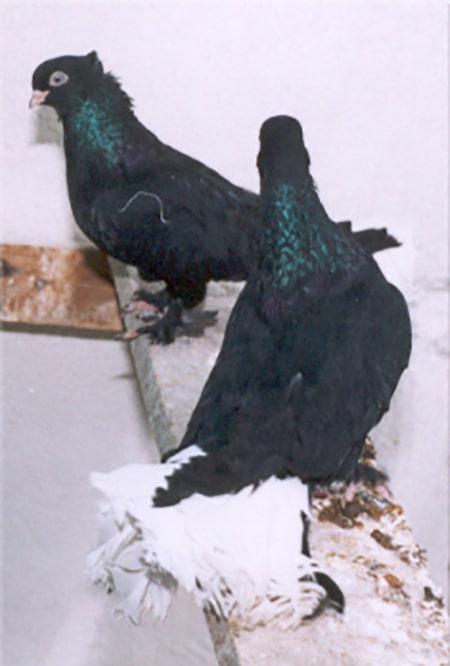
CONDITION OF SELÇUKS TODAY
During my research on Selçuks in Konya, I have noticed the number of fanciers that keep this breed has greatly reduced over the years. Ones that keep it tend to be the older fanciers of the city. Today there are about 10 to 15 people in Konya keep this breed. In my estimate there are about 200 to 250 birds exist in the city. Outside of Konya there are no other Turkish cities these birds exist. Some of the fanciers mentioned a transfer of some birds to Eskişehir at one time. However, I have no knowledge of their existence there. Konya's own pigeon bazaar called "Muhacir pazarı" that gets set up every Sunday gets large number of Taklas. I noticed 3 Selçuks and they were far from the standard form.
One of the biggest things I have noticed in this breed is the erosion of colors. Today in Konya only gök and akkuyrukkara is left. The other colors can't be found, or I should say they have become extinct. These extinct colors are ak, kara, pal, çopur and ala. I learned that the owner of "Deksan" firm is very interested in this breed in Konya. They have stated that he had purchased 4 of them for some outrageous amount of cash. Apparently, he has one other color. However, since I had no way of meeting with this person, I could not gather any more information. I met with Mr. Salim Bekler in Konya, gathered some information from him, analyzed his birds and photographed them.
Yavuz İşçen
